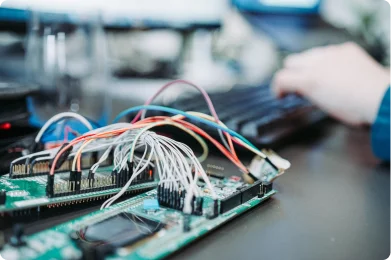You work for a company that most likely owns, uses, and manages hundreds (if not thousands) of IT and telecom assets. Now, you know this is all costing you money, because you have a lot of bills to pay every month for the usage of this business technology. But do you know where the money is actually going?

You probably don’t. In fact, many people don’t – to the extent that anyone is tracking this usage, they’re not using IT management best practices to do it. Don’t know what best practices in IT and telecom expense manage are? Not to worry – we’re here to help (and if you need a quick primer on what telecom expense manage is, here’s our helpful guide on the differences among telecom expense management (TEM), ITAM, and ITSM).
Read on to find out how your system of IT and telecom expense management stack up (and what you can do if they don’t).
Top 5 Best practices in TEM
1. IT and telecom inventory management
Inventory management is the real meat behind TEM. There’s no way you’re doing a good job of managing your assets if you don’t really know what you have. It’s a pretty basic idea, but one that’s hard to put into practice without a good system or software.
That’s why best practice in inventory management for TEM involves centralizing all the data on your IT and telecom assets into a single repository. That way nothing falls through the cracks. Also, you need to be able to search through this inventory with ease.
2. Order management
Your organization has to constantly upgrade phones, smartphones, and other telco devices. Or, you just need to buy more because you’re hiring more people all the time. You have to get more devices and services.
Now, you could do it without a plan or standardized process. That is, just let everyone and anyone buy… well, anything. Sadly, that way chaos lies.
That’s why the best practice in this regard involves having a formal process that’s aided by powerful software that helps you and your employees place orders with “safe” vendors, procure, and pay for them. Transparently.
3. Network and incident management
We all know that nothing’s perfect. The network will go down from time to time. There will also be moments when all the technology assigned to you will bug out for no apparent reason.
Now, some people try to keep some sort of log of these events with pen and paper, while others do nothing at all. The thing is, by doing nothing, you will lose sight of a problem that’s systemic. For that matter, even if you track all incidents on paper, you might not (in fact, you likely won’t) catch a bigger problem because you won’t get a big enough picture view. Let me show you what I mean with an example:
Say you only have 10 employees who use a certain wireline phone. Each employee experiences a bad breakdown of the phone. This is a good sign there might be something wrong with this model of phone, and that it’d be worthwhile to replace all of them so as to maintain your employees’ productivity (after all you have to pay them even if they can’t work).
But, say these breakdowns are spaced out over the year. You might catch the pattern if you have few employees. What happens when you have a lot? When you have no system in place to track this, you won’t even notice the problem. With a simple system (i.e., just pen and paper, or old spreadsheet style systems), you’d have to try pretty hard to find the pattern when there are a lot of data points.
And so, best practice here is to use automation (in the form of software) that helps you visualize usage or breakdown patterns for your network, devices, and services. That way, you can easily see wider disruptions for what they are – a problematic system that needs total replacement rather than a disconnected series of one-time events.
4. Invoice and contract management
Can you answer these questions accurately?
- Are you getting the right services?
- Are you paying what you’re supposed to be paying?
- Are you allocating your telco expenses correctly?
The answer to these question depends on whether you’re
using best practices. Non-best practice entails auditing your IT and telecom usage by hand, using multiple streams of legacy paper invoices. You’re coding, tagging, and allocating the costs, all by hand, and with minimal computer-based help (i.e., simple spreadsheets again).
The best practice here is to use electronic invoices fed into a system that does automated, ongoing analyses and reports of your usage and expenses.
5. Business intelligence
One of the best features of TEM is that you have a lot of valuable data in hand when you’re tracking all your usage. It’s a waste to not use this to help you steer your business.
That’s precisely what best practice TEM would give you. Using a dedicated TEM software tool that generates all manner of reports and does tons of complicated trend analysis that you can’t do on your own (or, even if you could, it’d still be faster and more comprehensive). You can see real (and big) trends before anyone else. You’d be ahead of the curve.
Why CimplManager matters (HINT: It gives you all the best practices in one package)
Oops. I spoiled that for you didn’t I?
Regardless, it’s true.
Spreadsheets were once the widespread, efficient way to sort and keep track of all your IT assets. It’s not a good idea anymore. Using spreadsheets is still faster than keeping notes with pen and paper, but it won’t keep up with the large volumes of technology that finds its way into companies.
People need to find faster, more cost-effective ways to manage IT and telecom. May I humbly submit: CimplManager.
CimplManager is our newest solution to make your IT and telecom expense management as efficient as possible. Administrators can conveniently access all the data they need to really know how much the IT and services used by staff costs. They can then accurately assign costs to cost centers, departments, and employees. In short, CimplManager gives you:
- Comprehensive, Fast Inventory Management. The at-a-glance dashboard provides updates on all asset types, services, contracts, and vendors. The fact that information about all your IT and telecom assets is put in one centralized repository makes inventory management much faster (recall the EDF, mentioned above)!
- Accurate, Versatile Report Tools. Spreadsheets are no longer needed with CimplManager. You can find all of your information in one place with no hassle. This lets you get insights quickly so that you can make better strategic decisions sooner rather than later about spending and budgeting.
- Convenient Range of Data Visualizations. You can visualize data in a number of ways (or even create your own view). This gives you more paths to understanding to your cost breakdown for all your IT and telecom assets.
- Automated Processes. Say goodbye to slow, error prone manual processes. CimplManager’s automated processes and workflows let you and your employees interact with vendors without delay.
- Optimized Procurement Management. You can manage MACDs (Move, Add, Change and Delete), user requests, and procurement processes in one system and in one place.
If you’d like details on CimplManager’s features, you can watch our short video that gives a quick overview of its most useful functions and download our brochure!
Final words for now…
To manage all the modern technology you have in your business, you need to have the most modern tools in hand. That’s exactly what you get with CimplManager – a cutting edge IT and telecom expense management solution. Talk to us if you’d like to ask more questions!
Related Articles:
- Why Shadow IT is a Problem That You Can Fix!
- Why Your Business Needs Information Technology
- ServiceNow Integration for Greater Telecom Inventory Accuracy





